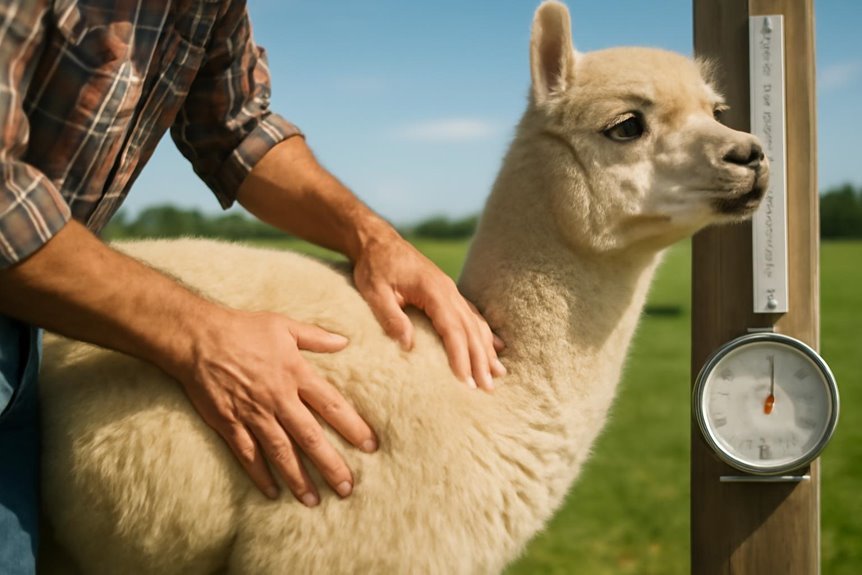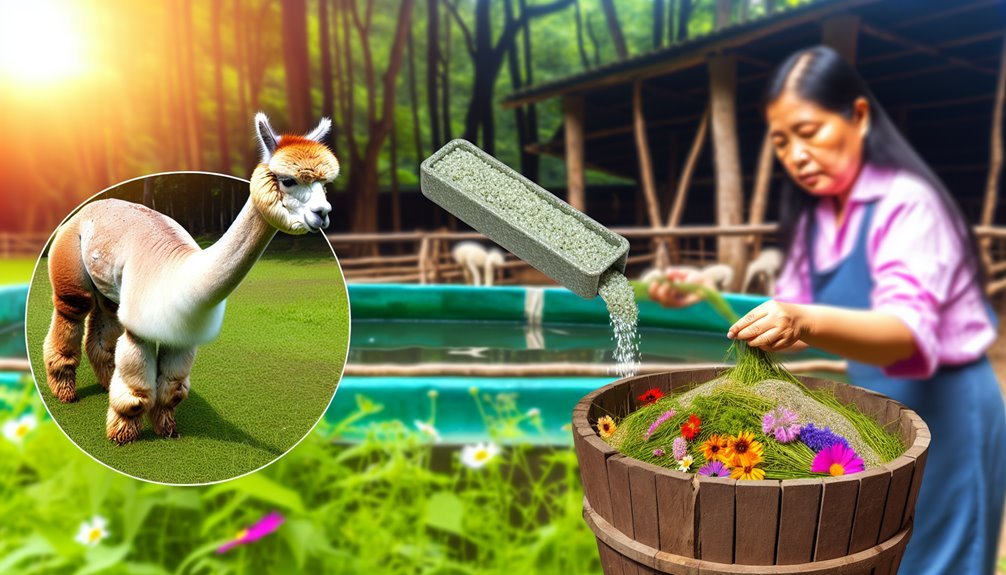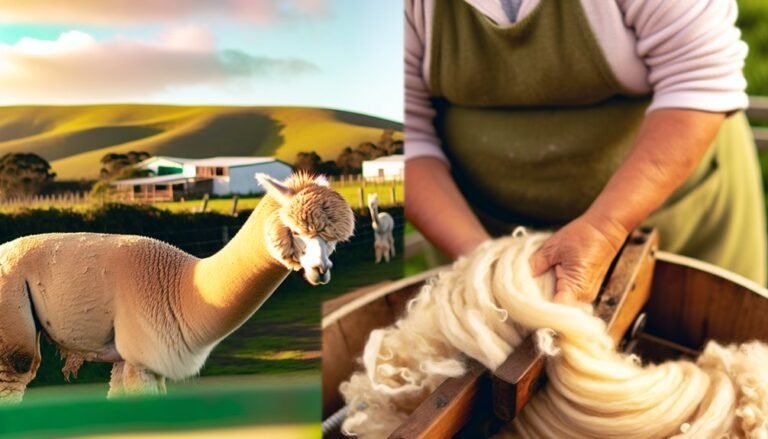10 Ways to Prevent Vitamin Deficiency in Alpacas
To prevent vitamin deficiency in your alpacas, make sure they get 2-4 hours of sunlight daily and manage pastures well to maintain quality. Use seasonal vitamin D supplements, especially in winter, and increase doses for crias and pregnant females. Provide balanced minerals, monitor body condition regularly, and rotate grazing areas to avoid overgrazing. Injectable or oral vitamin D can help, but always consult a vet for tailored plans. There’s more to learn about optimizing their health and growth.
Key Takeaways
- Provide alpacas with 2-4 hours of direct sunlight daily for natural vitamin D synthesis, especially during winter months.
- Administer vitamin D supplements, such as injectable or oral forms, based on weight and seasonal needs to prevent deficiencies.
- Regularly monitor alpacas’ body condition and growth rates every 4-6 weeks to detect early signs of vitamin deficiency.
- Maintain balanced nutrition including calcium, phosphorus, and magnesium to support metabolic functions and vitamin absorption.
- Consult a veterinarian for tailored supplementation plans and regular health check-ups to ensure optimal vitamin levels and prevent overdosing.
Ensure Adequate Sunlight Exposure Year-Round

Although alpacas can get some vitamin D from their diet, guaranteeing they have direct sunlight exposure for at least 2-4 hours daily is essential, especially during winter months when UV light is scarce. You should provide access to open pastures where your alpacas can soak up natural sunlight exposure, which is critical for vitamin D synthesis. If your farm is located at higher latitudes or altitudes, your alpacas may need more time in the sun to stay healthy. Keep a close eye on crias born in winter since they’re more vulnerable to deficiency due to limited sunlight exposure. Additionally, offering sheltered areas where alpacas can safely bask in the sun helps maintain consistent sunlight exposure year-round, and rotating grazing areas ensures they get the best sun without overgrazing.
Implement Seasonal Vitamin D Supplementation
While ensuring your alpacas get enough sunlight is important, the reduced UV exposure during winter means their natural vitamin D production often isn’t enough. That’s why implementing seasonal vitamin D supplementation is essential to prevent deficiencies.
Reduced winter sunlight limits alpacas’ vitamin D production, making seasonal supplementation vital to prevent deficiencies.
Here’s how to manage it effectively:
- Start supplementation in late autumn and continue through early spring to support growth and prevent rickets.
- Administer 6000 IU of vitamin D per kg of body weight subcutaneously every 8 weeks for sustained levels.
- Always consult a veterinarian to tailor vitamin D supplementation to your herd’s specific needs and avoid overdosing.
Monitor and Adjust Dosage for High-Risk Alpacas
Because some alpacas have higher vitamin D needs, you’ll want to closely monitor and adjust their dosage accordingly. High-risk alpacas—like those with darker coats, pregnant or lactating females, and young crias—are more prone to vitamin D deficiency and need careful attention. For growing crias born in autumn or winter, increasing supplementation to about 900 IU/day during colder months helps offset limited sunlight. To effectively monitor and adjust dosage for high-risk alpacas, regularly assess body condition and watch for signs like lameness or weight loss. Always consult your vet before changing vitamin D amounts, as over-supplementation risks toxicity. Timely adjustments based on professional guidance guarantee these alpacas stay healthy and avoid complications linked to deficiency.
Provide Balanced Nutrition Including Essential Minerals

To keep your alpacas healthy and prevent vitamin deficiencies, you need to provide balanced nutrition that includes essential minerals like calcium, phosphorus, and magnesium. These minerals support bone health and overall metabolic functions. Here’s how you can guarantee your alpacas get what they need:
- Regularly assess pasture quality to identify mineral gaps, adjusting feed accordingly.
- Include supplements rich in calcium, especially if pasture lacks this crucial mineral, to prevent issues like rickets.
- Balance protein intake to improve absorption and utilization of vitamins and minerals.
Use Injectable Vitamin D for Long-Term Coverage
You’ll want to follow dosage guidelines carefully, giving 1,000 to 1,500 IU of injectable vitamin D per kilogram of your alpaca’s body weight. Injections every 12-16 weeks, especially through winter, help maintain steady levels when sunlight is scarce. Compared to oral supplements, injectable vitamin D offers longer-lasting protection and reduces the risk of deficiency.
Dosage Guidelines
One effective way to guarantee your alpacas get long-term Vitamin D coverage is by using injectable forms, which last about 12 to 16 weeks per dose. When following dosage guidelines, keep these points in mind:
- Administer 1,000 to 1,500 IU per kilogram of body weight to assure proper Vitamin D levels.
- Start injections in October to prepare alpacas for winter when sunlight is limited.
- Use concentrated injectable products (100,000 IU/ml) like Belavit AD3E, dosing carefully based on weight for accuracy.
Injection Frequency
Although injectable vitamin D offers long-term coverage, you should administer doses every two months during low sunlight periods, typically from October through March or April. This schedule guarantees your alpacas maintain adequate vitamin D levels when natural UV exposure is limited, preventing deficiencies that can affect their bone health. Be sure to calculate the correct dosage based on each alpaca’s body weight, generally between 1,000 to 1,500 IU per kilogram. To reduce the risk of injection site abscesses, rotate where you give the shots each time. Sticking to this injection frequency helps keep vitamin D levels stable over the months, supporting your alpacas’ overall wellness during times when they can’t produce enough vitamin D naturally.
Benefits Over Oral
Because injectable vitamin D lasts 12 to 16 weeks, it offers a more convenient and reliable option than oral supplements, which require more frequent dosing. Choosing injectable vitamin D for your alpacas means you get:
- Long-lasting coverage: One dose maintains adequate vitamin D levels for up to four months, reducing handling stress.
- Precise dosing: Administered based on body weight (1,000–1,500 IU/kg), injectable vitamin D minimizes overdose risks under veterinary guidance.
- Better absorption: Studies show injectable forms have equal or superior bioavailability compared to oral forms, ensuring your alpacas effectively utilize the vitamin.
Consider Oral Vitamin D Pastes as an Alternative
If you’re looking for a convenient way to supplement your alpacas with vitamin D, oral pastes are a great alternative to injections. They offer similar bioavailability and are easy to administer every 4-6 weeks, especially during low sunlight months. Just be sure to follow the recommended dosage of 1000 to 2000 IU per kilogram of body weight for effective prevention.
Benefits of Oral Pastes
Oral vitamin D pastes offer a convenient and effective way to supplement your alpacas without the need for injections. Using oral vitamin D pastes can simplify your supplementation routine while ensuring your alpacas get the nutrients they need. Here are three key benefits:
- Ease of Use: You can administer oral vitamin D pastes quickly without specialized skills or equipment, making it less stressful for both you and your alpacas.
- Reduced Health Risks: Unlike injections, oral pastes lower the chance of abscesses and other injection-related complications, promoting better animal welfare.
- Similar Efficacy: Studies show these pastes provide absorption rates comparable to injections, so your alpacas receive effective vitamin D support.
This alternative is readily available and helps you manage your herd’s health with less hassle.
Dosage and Administration
Maintaining the right vitamin D levels in your alpacas means carefully managing dosage and administration. Oral vitamin D pastes offer a practical alternative to injections, with a typical dosage of 1,000 IU/kg body weight every 4-6 weeks. For treating rickets, you might need to increase the dosage to 2,000 IU/kg, whether using oral or injectable forms. Large tubes containing 100,000 IU in 10 ml allow you to tailor the dosage precisely based on each alpaca’s weight. It’s essential to regularly monitor their weight to avoid under- or overdosing, which could cause deficiencies or toxicity. This careful attention guarantees your alpacas receive the right amount of vitamin D for peak health without the stress of injections.
Bioavailability Compared to Injections
While injections have been the traditional method for vitamin D supplementation in alpacas, recent studies show that vitamin D pastes taken orally can offer similar or even better bioavailability. You might consider oral pastes as a practical alternative because:
- Oral vitamin D is absorbed efficiently in the foregut without degradation, effectively raising serum levels.
- Unlike injections, oral pastes reduce risks like injection-site abscesses and can be administered more frequently.
- Both methods require precise dosing based on body weight, but oral pastes come in concentrated forms, simplifying administration.
Ultimately, the choice between injections and oral vitamin D pastes should follow veterinary guidance, tailored to your alpacas’ health and needs. This approach helps you maintain ideal vitamin D levels while minimizing complications.
Regularly Assess Body Condition and Growth Rates

Because alpacas can’t tell you when they’re not feeling well, regularly evaluating their body condition and growth rates is crucial to catch early signs of vitamin deficiencies. You should monitor their body weight and condition every 4-6 weeks using standardized scoring systems like the one from Penn State University. This consistent assessment helps you spot any sudden weight loss or poor growth, especially in crias, which could indicate vitamin D or other nutritional deficiencies. Tracking growth rates guarantees that young alpacas are developing properly and not falling behind. Early detection allows you to make targeted nutritional adjustments before the deficiency worsens. By keeping a close eye on these indicators, you’ll maintain your alpacas’ ideal health and reduce the risk of vitamin-related health issues.
Manage Pasture Quality and Stocking Rates Effectively
One key step to preventing vitamin deficiencies in your alpacas is managing pasture quality and stocking rates effectively. Overgrazed pastures reduce forage availability, which can lead to vitamin D deficiencies, especially during low sunlight periods. To maintain healthy alpacas:
- Calculate stocking rates based on pasture production to avoid overgrazing and guarantee consistent forage supply.
- Monitor pasture quality regularly and use soil testing to identify mineral deficiencies that affect nutrient content.
- Implement rotational grazing to allow pastures to recover, preserving nutrient levels critical for vitamin D synthesis.
Supplement Pregnant and Lactating Females Appropriately
To keep your pregnant and lactating alpacas healthy, you’ll need to time vitamin D supplementation carefully, starting about 4-6 weeks before birth. Calculating the right dosage, typically 6000 IU/kg every 8 weeks, is essential to guarantee effective absorption. Regularly monitoring mineral transfer helps prevent deficiencies from passing to your crias, so stay in close contact with your vet for tailored advice.
Timing of Supplementation
While alpacas can synthesize vitamin D from sunlight, pregnant and lactating females often need timely supplementation, especially during autumn and winter when exposure is limited. Getting the timing of supplementation right is vital to prevent deficiencies that affect both mother and cria. To guarantee ideal health, keep these points in mind:
- Begin vitamin D supplementation 4-6 weeks before parturition to boost colostrum quality and support fetal growth.
- Administer 6000 IU per kilogram of body weight subcutaneously every 8 weeks during pregnancy.
- Continue supplementation through lactation to support milk production and cria development, especially in low-sunlight regions.
Dosage Calculations
Because vitamin D needs can vary widely among pregnant and lactating alpacas, you’ll need to calculate dosages carefully based on each animal’s body weight to assure effective supplementation. The recommended dose is 6000 IU/kg body weight administered subcutaneously every 8 weeks. Starting supplementation 4-6 weeks before parturition assures colostrum contains enough vitamin D for the newborn cria. For lactating females, you might need to adjust vitamin D intake depending on seasonal sunlight and individual health. Accurate dosage prevents deficiencies and supports fetal development and milk production. Always consult your veterinarian to create a tailored plan that considers environmental factors and your alpaca’s specific requirements, assuring safe and effective vitamin D supplementation throughout pregnancy and lactation.
Monitoring Mineral Transfer
Ensuring proper mineral transfer from mother to cria is critical, especially when it comes to vitamin D and other essential nutrients. To support this, you need to supplement pregnant and lactating females carefully. Here’s how you can monitor and optimize mineral transfer:
- Start vitamin D supplementation 4-6 weeks before birth to boost colostrum quality and support cria development.
- Administer around 6000 IU/kg of vitamin D every 8 weeks throughout gestation for pregnant females to maintain adequate mineral levels.
- Regularly assess the body condition of your females and consult a vet to customize supplementation plans, ensuring both mothers and crias get what they need.
Consult a Veterinarian for Customized Supplementation Plans
If you want to keep your alpacas healthy and prevent vitamin D deficiency, consulting a veterinarian is crucial. Veterinary services provide tailored supplementation plans based on your alpacas’ age, health, and environment. A vet guides you on the right vitamin D dosage—usually around 30 IU/kg daily—and adjusts it for seasonal sunlight changes. Regular check-ups help spot early deficiency signs like lameness or weight loss, allowing timely treatment. Your veterinarian will also recommend the best way to give supplements, whether injections or oral options, suited to each alpaca. Most importantly, they prevent overdosing by closely monitoring vitamin D levels. Relying on professional advice guarantees your alpacas get exactly what they need for optimal well-being without risks.
Frequently Asked Questions
How to Prevent Vitamin Deficiencies?
To prevent pesky vitamin pitfalls, you’ll want to provide proper dietary supplements daily. Don’t delay; diligent dosing during darker days guarantees your alpacas stay strong, sprightly, and supplemented, sidestepping sickness and supporting sustained, sound health.
What Vitamin Deficiency Do Alpacas Have?
You’re likely to encounter vitamin D deficiency in alpacas, especially with limited sunlight. Vitamin sources like supplements and injectable forms help maintain their health, preventing issues like rickets, lameness, and poor growth in your animals.
How to Keep Alpacas Healthy?
You’ve got to feed your alpacas like nurturing a garden—balanced alpaca nutrition with quality forage and supplements keeps them vibrant. Regular vet checks and monitoring body condition help you catch issues early, ensuring lasting health.
How to Prevent Vitamin a Deficiency in Cattle?
To prevent vitamin A deficiency in cattle, you should focus on cattle nutrition by providing high-quality forage, supplementing with vitamin A injections or pastes, monitoring health regularly, and offering mineral supplements during low forage periods or winter months.







Our picks
Alpaca & Wool Felted Sole Inserts: Comfy Upgrade?
Best Alpaca Socks for Hiking: Ultimate Comfort and Durability on Trails
Best Alpaca Halter for Comfort and Control